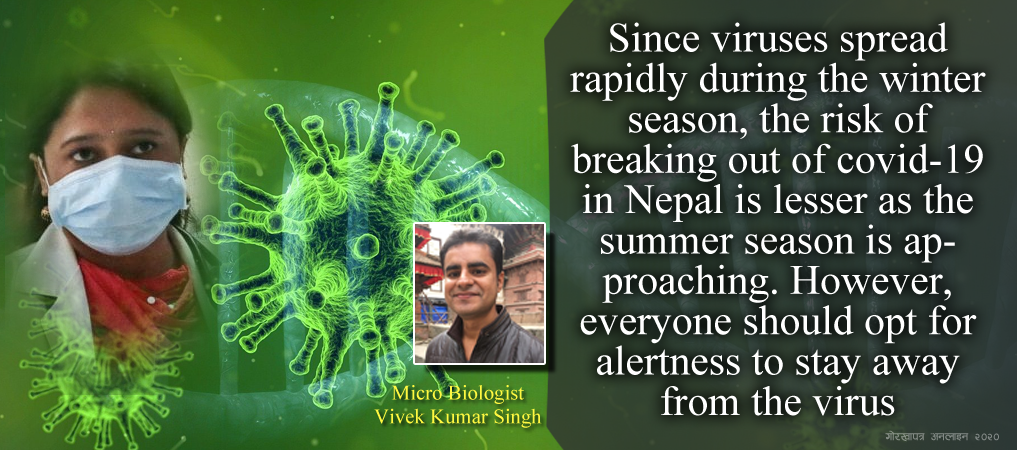Virus outbreak risk lesser in summer, albeit Nepal needs to adopt high alertness
COVID-19 (novel coronavirus)

By Ishwar Chandra Jha, Kathmandu, Feb. 28: Amid the outbreak of deadly COVID-19 in China and its spread in other countries, the health specialists have suggested that Nepal should adopt high alertness to stay unaffected from the virus.
Since viruses spread rapidly during the winter season, the risk of breaking out of COVID-19 in Nepal is lesser as the summer season is approaching. However, everyone should opt for alertness to stay away from the virus, said Bibek Kumar Singh, Investigation Officer, Public Health and Epidemiological Investigation Center.
Even though COVID-19 is being perceived as a life-taking disease all around the world, this hasn’t been proved anywhere. Our journalist, Ishwar Chandra Jha talked to Singh about the myths and threats in relation to the novel coronavrirus or COVID-19. Excerpts:
No one has been able to establish exact origination of COVID-19. How do you think the virus broke out in China?
The evolution of COVID-19 is yet to be answered. It is identical to some viruses which are transmitted by animals; hence, people have been predicting that it might have evolved from wild animals. The evolution is still unknown but the transmission is human-to-human. The winter season as well has favored the transmission.
In what conditions are people more likely to be affected by virus? Why do viruses spread more rapidly in winter?
Different viruses have different seasonal peaks. Some spread in summer, some spread in winter and few spread in autumn as well. Transmission of flu virus is most frequent in the winter season.
During the cold, the envelope of flu virus gets converted into gel like structure and hence the virus retains while transmitting from one person to the other.
In hot days, the envelope gets converted into liquid like structure and the virus gets destroyed while transmitting.
Is Nepal in risk of COVID-19?
Not only Nepal, the entire world is at risk of COVID-19 infection.
Most importantly, if we do have an outbreak then it would be difficult to get control over it as we do not have good preparedness compared to other nations.
What are the types of viruses?
Virus can be classified through various ways, some of them are,
Firstly, on the basis of host; virus can be classified into animal, plant and bacterial viruses.
Secondly, on the basis of viral genome, it can be classified into DNA and RNA viruses.
Lastly, on the basis of envelope, virus can be enveloped and non-enveloped.
What is biological weapon?
Use of biological agents (like bacteria, virus, fungi, toxi) as a weapon to initiate/defend war is biological weapon.
How are biological weapons created?
The production process for biological weapon is very easy and cheap in comparison to other arms. We can take an example of vaccine production and relate it with the bio-weapon production.
First, the desired bacteria, virus or fungi is produced in mass. It is then mixed with an agent through which/whom it can transmit.
For instance, if it is a virus which can transmit through air, then the virus will be exposed to air. Likewise, if it can be transmitted through water, then it is mixed with water.
At times, ticks or insects are used to transmit virus. In cases as such, the insects or ticks will be infected with the desired bacteria and then the insect transmits the disease to humans.
Since when did the biological weapon come into use?
The first documented case was during 1500-1200 BC where, Tularemia victims were used as biological weapons.
When was the biological weapon last used?
Biological weapon was frequently used until World War II. In 1972, the UN banned the use of biological weapon and since then its use has completely stopped.
What are its types? Also, how deadly are biological weapons?
Biological weapons can be bacterial, viral, fungus or toxic.
They are extensively hazardous and difficult to detect. Thousands of people get infected before the outbreak even gets identified.
Recent News

Do not make expressions casting dout on election: EC
14 Apr, 2022
CM Bhatta says may New Year 2079 BS inspire positive thinking
14 Apr, 2022
Three new cases, 44 recoveries in 24 hours
14 Apr, 2022
689 climbers of 84 teams so far acquire permits for climbing various peaks this spring season
14 Apr, 2022
How the rising cost of living crisis is impacting Nepal
14 Apr, 2022
US military confirms an interstellar meteor collided with Earth
14 Apr, 2022
Valneva Covid vaccine approved for use in UK
14 Apr, 2022
Chair Prachanda highlights need of unity among Maoist, Communist forces
14 Apr, 2022
Ranbir Kapoor and Alia Bhatt: Bollywood toasts star couple on wedding
14 Apr, 2022
President Bhandari confers decorations (Photo Feature)
14 Apr, 2022











